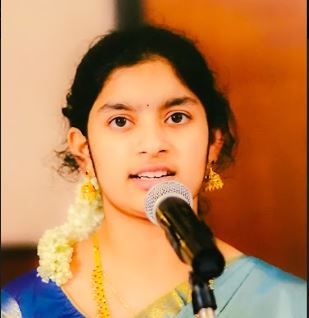Name that Tune: A Closer Look at Carnatic Music

At the Multicultural Dinner in March every year, students showcase their cultural abilities in the Morris Hills cafeteria. This year, Giselle Gonzales and Brian Cadavos impressed the crowd by performing in the style of Filipino music. Sneha Ranade looked stunning in her dress as she danced to a Bollywood tune, and Ananya Vasireddy wowed the cafe with her smooth voice. Another prominent style of vocal music performed hails from South India, and goes by the name of Carnatic Music. This type of music is less popular than the others performed, and more mysterious. So, what is carnatic music?
Carnatic Music first originated in South India in the early 1400s, and is known to be an ancient art. The first three composers of this style of music wrote music that praises the lords of Hindu religion. It is tradition for the singer to sit on the floor, with both legs crossed, and sing in front of god. The music was performed for the public and has been passed down many generations.
This style of music is similar to Western music in the sense that there are multiple scales in which compositions can be performed, or ragas, as they are called. The vast ocean of carnatic music encompasses more than 1000 different scales, all based off of 72 main parent scales. However carnatic music is more intricate, as it is formed upon the basis of shruti, or relative musical pitch, thalam, or rhythm, and swaram, the musical sound of a note. In Carnatic music there are 7 possible musical notes that can be used: Sa Ri Ga Ma Pa Da Ni. Each one of these notes is similar to the notes: Do Re Mi Fa So La Ti. With these three pillars, a vocalist can accomplish multiple things.
The first one of these things is singing a musical composition. Carnatic musical compositions consist of many layers. The first layer is the scale. Every composition is set in a different scale, and uses notes from that scale only. The second layer are the notes themselves. The third layer is the lyrics. Carnatic music is unique as each singer must be able to decode the tune and lyrics, and discover and learn the underlying notes. This is a phenomenon that is not common in Western music.
Once a singer is able to master the singing of a musical composition, they can move up to improvisation. Just as the set compositions, improvisation must be done under a specific scale. Vocal improvisation involves alapana, which is melodic improvisation used to develop a specific raga, swara kalpana, which is the improvisation of notes at the climax of a composition, and neraval, which is the improvisation of the tune of a specific set of lyrics of the composition.
Finally, when a student has learned all of the aspects of Carnatic music from their teacher, most importantly the realm of improvisation, it is tradition for him or her to perform a vocal arangetram, or debut concert. Accompanied by the violin, for backup, and the mridangam (South Indian drum) for rhythm, the vocalist utilizes all of their knowledge to perform in front of a large audience.

